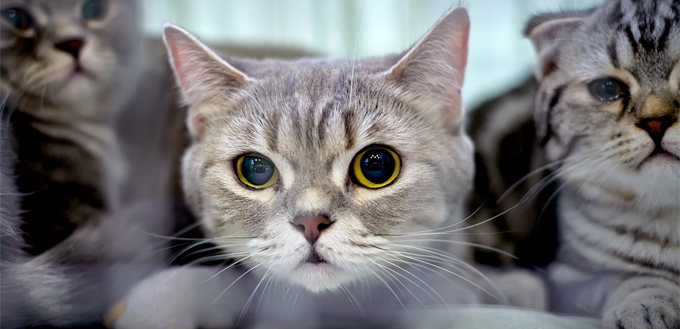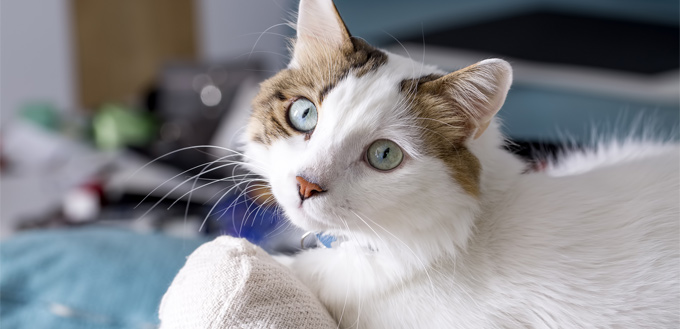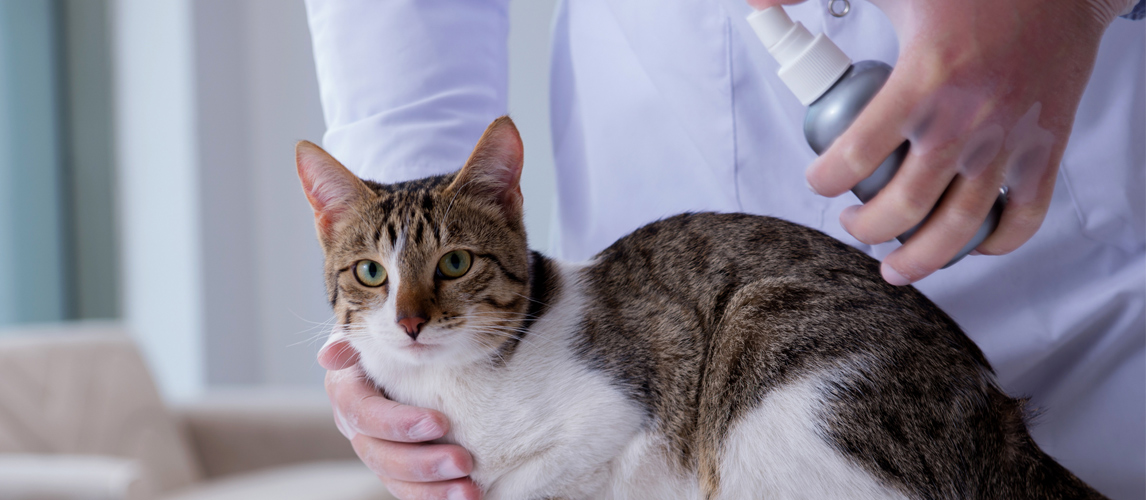Separation anxiety is a condition that we normally associate with dogs. Cats have a reputation for being very independent and aloof but they can, and do, form very strong attachments to their humans. It is very distressing for them when those humans are not around! Stress in cats is subtler than in dogs and has often progressed to a severe stage before it is even noticed.
As a cat owner, this condition is one that you need to know about so that you can look out for the signs and do something to remedy the situation if needed. As a note of caution, some of the symptoms of separation anxiety are also symptoms of other health conditions including urinary tract infection, intestinal diseases, hyperthyroidism, skin problems, allergies, and parasites. It is always best to have your cat checked over by a vet to rule these out before you assume that they have separation anxiety.
Here’s what you need to know about how to treat anxiety in cats.

Signs That Your Cat Has Separation Anxiety
If your kitty is showing any of the following signs, it could indicate that they have separation anxiety.
- Over-attachment: This is when your cat gets a little obsessed with seeking out your company. They become very ‘clingy’ and may follow you everywhere you go in your home.
- Vocalisation: Your cat may cry, moan or meow as you are leaving or just after you have left the house.
- Pre-departure anxiety: This is when a cat shows obvious anxiety and distress when you are getting ready to leave the house.
- Anorexia: A cat with separation anxiety will often be too distressed to eat when you are not at home. If you are away for long periods, this can result in a loss of weight.
- Failure to use the litter tray: When a cat fails to use their litter tray appropriately, it is usually a sign of illness or distress. A kitty with separation anxiety may mark areas around your house with urine (pee) or faeces (poop). They may also get diarrhoea.
- Elimination of human clothes: A very typical behaviour for a cat with separation anxiety is for them to poop or pee on your bedding, clothing or anything else that smells like you. They are trying to make themselves feel better by mixing their scent with yours and they think they are helping you to find your way home by leaving a scent trail for you to follow!
- Recurrent cystitis: Cystitis is an infection of the urinary tract and it causes a cat to pee very often and to pee outside of their litter-tray. When they get repeated infections, it can be a sign of stress.
- Vomiting: Cats can vomit for many different reasons but if your kitty only vomits when you are out, it can indicate stress brought on by the separation. An anxious cat may eat much too fast and this can sometimes cause vomiting as well.
- Excessive licking and grooming: Cats can start to groom themselves too much when stressed and this can lead to hair loss and skin problems.
- Destructive behaviour: A cat suffering from separation anxiety will not cause the carnage in a house that a dog can but they are more than capable of clawing and scratching door edges and carpets. Soft furnishings are another popular target.
- Over-enthusiastic greeting behavior: Does your cat greet you as if you have been away for six months when you have only been in work all day? This could be a sign of separation anxiety.
Related Post: Best Cat Litter Box
Why Do Some Cats Get Separation Anxiety?
Not all cats will suffer from separation anxiety and there are some risk factors that make it more likely to happen.
Cats that were taken away from their mother at a very young age are more likely to get separation anxiety. Kittens need to be with their mother and litter mates until they are at least eight weeks old. This is why orphaned kitties can suffer from many psychological and physical issues. Cats also need to be socialised with plenty of humans when they are between three and nine weeks of age. This helps them grow up into well-balanced and confident adult cats.
There is probably a genetic element involved here too. Some breeds, such as the Siamese and Burmese and other ‘highly strung’ breeds, are more likely to suffer from this condition. There is nothing that you can do to change your cat’s genetic make-up.
A large element of separation anxiety is boredom caused by a lack of stimuli. If a cat has very little to do, they will form an unusually strong attachment to their owner. Cats are also sensitive to changes in their home life which can trigger an episode of separation anxiety. Things like a house move, the death of a family member, the death of a pet or the arrival of a new baby or pet are typical examples. Think about your own emotions because they could have a role to play. Your cat can detect any anxiety that you have when you leave the house.

Treatment Options for Separation Anxiety
Vets can recommend a variety of treatment options for separation anxiety in cats and it is important that you follow their advice. They may start with behavioural modifications but medication is available if needed. You will be involved in the treatment and some lifestyle adjustments may be required. The aim of any treatment is to reduce stress and improve stimulation. Some owners also choose to work with pet behaviour experts or therapists. Here are a few strategies that you may be asked to try.
Check out our guide on anti anxiety for cats.
Play with Your Cat
Make time to give your cat your undivided attention two or three times every day. Play with them using a variety of cat toys and let them pretend that they are catching prey. If they choose to start playing alone, encourage them to do so by praising them and giving them treats. Don’t reward them for clingy or demanding behavior such as excessive meowing.
Related Post: Cat Calming Treats
Provide Plenty of Stimulation
Providing plenty of things for your cat to play and interact with is called ‘environmental enrichment’ by pet experts. For a cat to feel satisfied and entertained when they are home alone, they need plenty of things to occupy them. Some ideas could be:
- Cat trees: These are vertical play areas with a number of different activities and resting areas where cats can perch and play. Kitties love to be in high places where they feel safe. If they have a good view of what is going on in the garden or out in the street that it’s even better. Some owners place a bird feeder within sight so their cat has something to keep them totally engrossed!
- Scratching posts: These are made of a robust material that cats love to run their claws down. It will draw your cat’s attention away from your sofa and give them a focal point to use to mark their territory. A vertical scratching post is best and, if possible, have several of them around the house. Move them around until you find the place where your cat is most happy to use them.
- Puzzle feeders: These are very effective for relieving stress, boredom, and anxiety in cats because they have to focus on them to get hold of their food. The puzzle feeders provide a positive and challenging activity for your kitty to enjoy whilst you are out. Something as simple as some dry kibble in an elbow fitting pipe can keep a cat amused for hours. Their instinct to forage and hunt will over-ride their anxiety.
- Toys: The choice of cat toys is endless – all you have to do is find something that appeals to your cat. A mobile toy is a good option, your cat will chase it around your house whilst you are out. Some owners like to add some Catnip (a herb called Nepeta cataria) which mimics feline pheromones and makes cats go crazy.
- Hideaways: Cats love to hide away in small places. Provide some all over your house to help your kitty feel safe and secure.
Coping Strategies
Your vet may suggest a number of coping strategies for your cat.
- Identify anxiety triggers: These are the sights and sounds that your cat associates with being left alone. They learn that things like you putting on your coat or your house keys jangling means that they are about to be left alone. Other possibilities are: you getting your shoes out of a closet or picking up your briefcase. This acts as a trigger for their anxiety. Each cat and each household will have different anxiety triggers so take a week or so to work which is bothering your kitty.
- Control the triggers: Once you know what the anxiety triggers are, you can start to work on them. Prepare to leave the house a few times a day but don’t actually go. Pick up your keys and then put them back down again. Put on your shoes, walk around in them, and then take them off and sit down. The aim is to break the association between the trigger and your cat being left alone.
- Build up slowly: Once your cat has stopped getting stressed about the triggers you should start to leave the house for short periods of time. Pick up your keys (or whatever another trigger applies) and go out for one minute. Come back in, greet and play with your cat and then go back to your usual activities. Build this up to five and then 10 minutes and then for longer periods. Your neighbours may think that you are crazy but it does work so stick at it!
- Work on your leaving routine: If you are stressed and hurried when you leave the house, it will be transmitted to your pet. Get up half an hour earlier in the morning so that you can have a relaxed routine. Always make sure that there is enough food and water and that the litter tray is clean and accessible. Put out some toys and a puzzle feeder containing their favourite treats. Don’t make a big deal about saying goodbye or set up an elaborate ritual. Just calmly walk out of the door.
- Arrange some constant noise: When humans are at home, there is a constant noise. The TV or radio is playing and there are various domestic appliances making a noise as well as conversation. A silent house is going to make your cat feel even more anxious. You can overcome this by leaving the TV or radio playing on a low volume when you are out. Cats respond well to calming classical music so you could also put on an album for them!
- Pheromone products: Some cats respond well to artificial pheromones that can be sprayed around the house. Your choice of the best cat calming spray will depend on your cat’s age and breed.
- Monitoring progress: To get a clear idea of how anxious your cat gets when you are away, you may want to invest in a pet camera. These are like home security cameras and are available to suit all budgets. Some stream the images to your mobile. Others have a screen in your house that allows you to talk to your cat and even play with them with a laser. Hearing your voice can be very soothing and playing a quick game will distract them. You have to be very careful that the beam is not pointed directly at their eyes.
Check out our guides on Calming Collar for Cats and Laser Pointers for Cats.
If none of these options work, go back to your vet and discuss if cat anxiety medication is a possible option. Of course, the ultimate remedy is to employ a cat sitter but this is not a viable proposition for everyone in terms of lifestyle and cost.
Sources:
- Stefanie Schwartz, DVM, MSc, DACVB, Separation Anxiety Syndrome In Cats: 136 Cases, American Veterinary Medical Association
- Crystal Munguia, Separation Anxiety in Pets: Your Questions Answere, College of Veterinary Medicine
Note: The advice provided in this post is intended for informational purposes and does not constitute medical advice regarding pets. For an accurate diagnosis of your pet's condition, please make an appointment with your vet.






